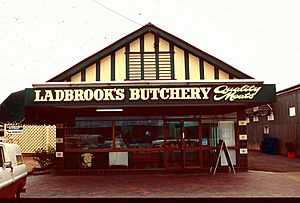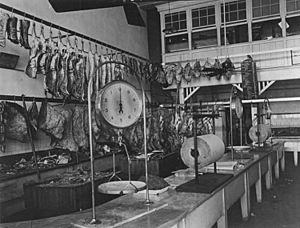State Butchers Shop, Roma facts for kids
Quick facts for kids State Butchers Shop |
|
|---|---|

State Butchers Shop, Roma, 2000
|
|
| Location | 75 Arthur Street, Roma, Maranoa Region, Queensland, Australia |
| Design period | 1914 - 1919 (World War I) |
| Built | 1919 |
| Architect | Government Architect's Office |
| Official name: State Butchers Shop (former), Bushell's Meats, Dore & Donald Butchers, Ladbrook's Butchery | |
| Type | state heritage (built) |
| Designated | 27 April 2001 |
| Reference no. | 602155 |
| Significant period | 1919 (fabric) 1910s-1920s (historical) |
| Significant components | cold room/cold store, toilet block/earth closet/water closet |
| Lua error in Module:Location_map at line 420: attempt to index field 'wikibase' (a nil value). | |
The State Butchers Shop in Roma is a historic building. It was built in 1919 as a special butcher shop run by the Queensland Government. This shop was part of a bigger plan to help people get meat at fair prices. Today, it is still used as a butcher shop and is known as Ladbrook's Butchery. It is listed on the Queensland Heritage Register because of its important history.
Contents
Why the Government Opened Butcher Shops
Helping Families with Fair Prices
Back in 1915, during World War I, the Labor government in Queensland wanted to make life better for families. Prices for everyday goods were very high. The government believed that by owning businesses, they could sell things like meat for less money. This would help lower prices for everyone, even at private shops.
State-Run Businesses: A New Idea
The government started many different businesses. These included:
- An insurance office
- A public trustee office
- The Golden Casket lottery
- Sawmills
- Fishing businesses (with State Fish Shops)
- Cattle stations
- And a network of butcher shops!
They called this "State capitalism." It meant the government owned businesses to compete with private companies. Their goal was to protect people from high prices, not to take over all businesses.
How the State Butcher Shops Worked
Providing Affordable Meat
Cattle farming was a huge industry in Queensland. Meat was a main food for many families. The government wanted all Queenslanders to buy meat at fair prices. They also needed to supply cheap meat to soldiers during the war. So, they started the State butcher shops.
The very first State butcher shop opened in Brisbane in November 1915. Soon, more shops opened in Brisbane and in regional towns like Rockhampton and Townsville. Frozen meat was sent to these shops by train. In total, 90 State butcher shops opened across Queensland over time.
Roma's Important Role
The town of Roma was a key center for the State butcher shop network. It was a large town in a big farming area. Roma also served as an important place to distribute meat. This meat came from the State-owned Charleville Meatworks, which was further west along the railway line.
Building the Roma State Butcher Shop
A Purpose-Built Design
In late 1918, the government decided to open a State butcher shop in Roma. They looked at existing butcher shops to see if they could buy them. However, these shops were not modern enough. So, the government decided to build a brand-new, up-to-date shop.
While the new building was being planned, two temporary State butcher shops opened in Roma in March 1919. These were in rented buildings.
A Modern Brick Building
By May 1919, land was bought in Arthur Street for the new shop. Plans were drawn up by the Queensland Government Architect's office. The new brick building was finished by October 1919. It cost over £4,000, making it one of the more expensive State butcher shops built.
The new shop had many special areas:
- An office
- A main shop area
- A breaking-down room (for cutting meat)
- A salting-room
- A cold room
- A country order department
- A store room
- An engine-room
Few Custom-Built Shops
The Roma shop was one of only six State butcher shops that were specially built. Most of the other 90 shops operated from rented or already existing buildings. The Roma shop was also one of the most solid, made entirely of brick.
The End of the State Butcher Shops
Changing Times and Sales
Even though the State enterprises helped people, they faced financial challenges. Some businesses were bought for too much money, others were poorly managed, or suffered from economic problems.
By 1926, the Labor government decided to sell off the businesses that were not making a profit. Some State butcher shops, including the Roma shop, were sold between 1926 and 1928. When the Labor government lost the election in 1929, the new government sold most of the remaining State enterprises. The last 39 State butcher shops closed on June 30, 1929.
A Lasting Impact
Over 14 years, the State butcher shops sold more than £5 million worth of meat. They made a profit for the government, even though they had some losses when all costs were added up. More importantly, they helped thousands of Queensland families get cheaper meat.
The State butcher shop in Arthur Street, Roma, was sold in July 1928. It was bought by local butchers Dore and Donald Ltd. Today, it continues to operate as a butcher shop, now known as Ladbrook's Butchery.
What the Building Looks Like Today
The former Roma State Butcher's Shop is a single-story brick building. It has a gabled roof at the front and a hipped roof at the back, all covered with corrugated iron.
The front of the building has a decorative gable with vertical painted timbers. There is a modern awning over the front entrance. The shop front itself has been updated with modern aluminum.
On the south side, there are two original high windows that are now blocked. The building has different brick patterns, showing how it was built. Inside, there is an L-shaped shop area with modern counters. There are doors leading to a large cold room and a meat preparation area.
The stables that were built around 1920 are no longer there. There is a small separate toilet block near the building.
Why the Shop is Important to History
The former State Butchers Shop in Roma is important for several reasons:
- Shows Queensland's History: It helps us understand a time when the Queensland government tried to help people by providing cheaper meat. The network of State butcheries was a big part of this plan. The Roma shop was especially important as a distribution center for meat from the Charleville Meatworks.
- A Rare Example: This shop was one of only six State butcher shops that were specially built from scratch. Most others were in rented buildings. It was also one of the most solid, built entirely of brick.
- Shows What a State Butcher Shop Was Like: The building has remained a butcher shop. It still shows us what a purpose-designed State butcher shop from that time would have looked like.


